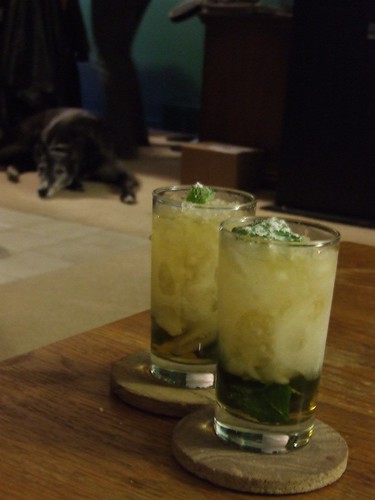
In honor of this weekend's Kentucky Derby, this week's drink was the Mint Julep.
The Mint Julep
2 oz Whiskey
1 oz simple syrup
A dozen leaves fresh mint
powdered sugar
A silver julep cup or collins glass
Muddle mint leaves in the simple syrup in the bottom of the glass until broken and the oils are released.
Add the whiskey. Stir it all together.
Fill glass overflowing with chipped ice.
Garnish with a sprig of mint coated in powdered sugar.
In my mind, the Mint Julep is so associated with Kentucky that it should be made with burbon, but we only had an ounce of Jim Beam bourbon left, and the only other burbon in the house is the Eagle Rare, which we won't be mixing drinks with. So, the for the rest of the whiskey, we used Jack Daniels as we have been using for other whiskey based drinks. Pretty soon, we'll have to move on to using up some of the other whiskeys in the basement bar.
Based on what I learned at the Buffalo Trace distillery, the differences between burbon and other whiskeys are as follows: 1) burbon is made in a certain area of Kentucky. This is significant because of the unique limestone hills there. The calcium in the limestone is taken up by the grass that the horses eat and that is what makes it such good country for raising horses that not only does the arguably most famous horse race in the world take place there, but many international horse owners stable their horses there during most of the year. The water contains the calcium and changes the flavor profile of the whiskey, just as the granite in Scottish highlands makes the difference between highland and lowland whiskey. 2) Burbon's primary ingredient is corn (maize). Grains typically used in whiskey are rye, barley, wheat, and corn. Changing which is the primary ingredient changes the flavor. Scotch malt whiskey is made primarily from malted barley. Using corn as the primary ingredient means that the whiskey is sweeter. 3) Bourbon must be aged in new, charred oak barrels. These barrels are often subsequently used by other distillers to age their spirits, including the majority of Glenlivet, Glenfiddich, and Glenmorangie single malts. 4) Burbon must be aged at least two years. If you're lucky, the stuff in the drinks gun is a toddler. The stuff not found on the bottom shelf is generally aged at least six years. See other technical information about the legal definition of burbon here. Actually, Tennessee whiskey meets the legal definition of burbon, and can officially be sold as such, but of course, it doesn't have the same water, and tends to use a special filtration process. At any rate, Tennessee whiskey is not a bad substitute for burbon.
Given the amount of water or melted ice, and the lack of a bitter component, the Mint Julep is more of a twist on The Sling than a cocktail. Apparently, as mentioned on 12BottleBar and in the video clip linked to below, juleps were originally ancient Persian drinks of herbs macerated in sugar syrup, and they were often used in more recent times for medicine delivery. It was here in the US in the 19th century that juleps were combined with alcohol, and the rest is history. Now, they are thought of as the perfect relief on a long, hot, Southern summer day.
Watch a master mix one up and recite poetry about it at the same time.*
Surprisingly, I had never tried one before, though I have had mojitos plenty of times since my first one years ago at Loca Luna, a tapas restaurant in Atlanta. The mojito recipe I have used is from fellow MyFolia gardener Mondomuse, from when I was super active there. (I still really like the site, there are just too many sites taking up my internet time, so I use it more sparingly.) The Mojito is similar to the Mint Julep in that it is a sweetened, iced, mint mixed drink. It is different in that it contains club soda and lime, and the spirit used is rum.
The verdict: All four of us at the table thought the julep was delicious. I think that the julep is a much more subtle drink than the mojito, and because the rum in the mojito is a white rum, it is a spirit with less flavor and character. The julep is, I think, a more interesting drink, even though it contains fewer ingredients. Despite the fact that it is rather diluted due to the ice, it doesn't taste weak. It doesn't seem to be common on menus, and I was afraid that it had been abandoned because of an old fashioned (in a bad way) flavor profile, but that isn't true at all. The mint goes beautifully with the sweetened whiskey. It is a really lovely drink.
*Ignore what the video says about the silver cup conducting the heat of the alcohol. Obviously, alcohol at room temperature doesn't have a different physical heat from the room, and even if it did, heating up a glass will not cause condensation on it. I suspect the trick of the silver cup feeling cooler is that it cools your hands and lips as their heat is conducted into the glass to melt the ice. Also, unlike glass, silver is reactive, so it may lend something to the flavor profile.
Oh, that looks so refreshing. I don't know why I don't drink mint juleps more often. Maybe I will now!
ReplyDeleteWe had some on Friday at a restaurant, and this recipe was much better.
ReplyDelete